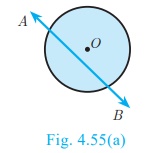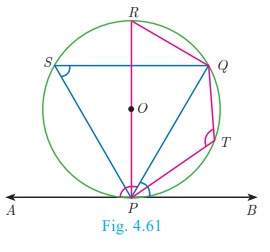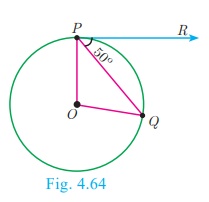Theorem, Statement, Proof, Construction, Solved Example Problems | Geometry - Circles and Tangents | 10th Mathematics : UNIT 4 : Geometry
Chapter: 10th Mathematics : UNIT 4 : Geometry
Circles and Tangents
Circles and Tangents
In our day-to-day real life situations, we have seen two lines
intersect at a point or do not intersect in a plane. For example, two parallel
lines in a railway track, do not intersect. Whereas, grills in a window
intersect.

Similarly what happens when a curve and a line is given in a
plane? The curve may be parabola, circle or any general curve.
Similarly, what happens when we consider intersection of a line
and a circle?
We may get three situations as given in the following diagram

Note
The line segment AB inscribed in the circle in
Fig.4.52(c) is called chord of the circle. Thus a chord is a
sub-section of a secant.
Definition
If a line touches the
given circle at only one point, then it is called tangent to the circle.
Real life examples of tangents to circles
(i) When a cycle moves along a road, then the road becomes the
tangent at each point when the wheels rolls on it.
(ii) When a stone is tied at one end of a string and is rotated
from the other end, then the stone will describe a circle. If we suddenly stop
the motion, the stone will go in a direction tangential to the circular motion.

Some results on circles and tangents
1. A tangent at any point on a circle and the radius through the
point are perpendicular to each other.

2. (a) No tangent can be drawn from an interior point of the
circle.

(b) Only one tangent can be drawn at any point on a circle.

(c) Two tangents can be drawn from any exterior point of a circle.

3. The lengths of the two tangents drawn from an exterior point to
a circle are equal,
Proof : By 1. OA ┴ PA,OB ┴
PB . Also OA=OB= radius,
OP is common side. ∠AOP = ∠BOP
Therefore, ΔOAP ≅ ΔOBP . Hence PA
= PB

4. If two circles touch externally the distance between their
centers is equal to the sum of their radii, that is OP = r1
+ r2

Proof :
Let two circles with centers at O and P
touch other at Q.
Let OQ = r1 and PQ = r2
and let r1 > r2 .
The distance between their centers OP = d . It is
clear from the Fig. 4.57 that when the circles touch externally OP = d
= OQ + PQ = r1 + r2 .
5. If two circles touch internally, the distance between their
centers is equal to the difference of their radii, that is OP = r1
−r2 .

Proof : Let two circles with centers at O and P
touch each other at Q. Let OQ = r1
and PQ = r2 and let r1 > r2
.
The distance between their centers OP = d . It is
clear from the Fig. 4.58 that when the circles touch internally, OP = d
= OQ – PQ
OP = r1 −r2 .
6. The two direct common tangents drawn to the circles are equal
in length, that is AB = CD.

Proof :
The lengths of tangents drawn from P to the two circles are
equal.
Therefore, PA = PC and PB = PD.
gives PA − PB = PC – PD
AB = CD
Alternate segment
In the Fig. 4.60, the chord PQ divides the circle into two
segments. The tangent AB is drawn such that it touches the circle at P.
The angle in the alternate segment for ∠QPB (∠1) is ∠QSP (∠1) and that for ∠QPA (∠2) is ∠PTQ (∠2) .

Theorem 6 : Alternate Segment theorem
Statement
If a line touches a circle and from the point of contact a chord
is drawn, the angles between the tangent and the chord are respectively equal
to the angles in the corresponding alternate segments.

Proof
Given : A circle with centre at O, tangent AB touches the circle at P
and PQ is a chord. S and T are two points on the circle in
the opposite sides of chord PQ.
To prove : (i) ∠QPB =
∠PSQ and (ii) ∠QPA = ∠PTQ
Construction: Draw the diameter POR. Draw QR, QS and PS.

Example 4.24
Find the length of the tangent drawn from a point whose distance
from the
centre of a circle is 5
cm and radius of the circle is 3 cm.
Solution
Given OP = 5 cm, radius r = 3 cm
To find the length of tangent PT.

In right angled ΔOTP,
OP2 = OT2 + PT2 (by
Pythagoras theorem)
52 = 32 + PT 2
gives PT 2 = 25 − 9
= 16
Length of the tangent PT = 4 cm
Example 4.25
PQ is a chord of length 8 cm to a circle of radius 5 cm. The
tangents at P and Q intersect at a point T. Find the length of the tangent TP.
Solution
Let TR = y . Since, OT is perpendicular bisector of
PQ.
PR = QR = 4 cm

In ΔORP, OP 2 = OR2
+ PR2
OR 2 = OP2 − PR2
OR2 = 52 − 42 = 25
−16 = 9 ⇒ OR = 3 cm
OT = OR+RT = 3+y ... (1)
In ΔPRT , TP2 = TR2
+ PR2 … (2)
and ΔOPT we have, OT2 = TP2
+OP2
OT2 = (TR2 + PR2
) +OP2 (substitute
for TP2 from (2))
(3 + y )2 = y2 + 4 2
+ 52 (substitute for OT
from (1))
9 + 6y + y2 = y 2 + 16
+ 25 Therefore y = TR = 16/3
6y = 41 − 9 we get y = 16/3
From (2), TP2 = TR2 + PR2

Example 4.26
In Fig.4.64, O is the centre of a circle. PQ is a chord and the tangent PR at P makes an angle of 50° with PQ. Find ∠POQ .

Solution
∠OPQ = 90° − 50° = 40° (angle between the
radius and tangent is 90° )
OP = OQ (Radii of a circle are equal)
∠OPQ = ∠OQP = 40° (ΔOPQ is isosceles)
∠POQ = 180° − ∠OPQ − ∠OQP
∠POQ = 180° − 40° − 40° = 100°
Example 4.27
In Fig.4.65, ΔABC is circumscribing a circle. Find the length of BC.

Solution
AN = AM = 3 cm (Tangents drawn from same external point
are equal)
BN = BL = 4 cm
CL = CM = AC – AM = 9 – 3 = 6 cm
Gives BC = BL + CL = 4 + 6 = 10 cm
Example 4.28
If radii of two concentric circles are 4 cm and 5 cm then find the length
of the chord of one circle
which is a tangent to the other circle.
Solution
OA = 4 cm, OB = 5 cm; also OA ┴ BC .

OB 2 = OA2 + AB2
52 = 42 + AB2 gives AB2
= 9
Therefore AB = 3 cm
BC = 2AB hence BC = 2 ×3 = 6 cm
Construction
Construction of tangents to a circle
Now let us discuss how to draw
(i) a tangent to a circle using its centre
(ii) a tangent to a circle using alternate segment theorem
(iii) pair of tangents from an external point
Construction of a tangent to a circle (Using the centre)
Example 4.29
Draw a circle of radius 3 cm. Take a point P on this circle and draw
a tangent at P.
Solution
Given, radius r = 3 cm

Construction
Step 1: Draw a circle with centre at O of radius 3
cm.
Step 2: Take a point P on the circle. Join OP.
Step 3: Draw perpendicular
line TT’ to OP
which passes through P.
Step 4: TT ‘ is the required tangent.

Construct of a tangent to a circle (Using alternate segment
theorem)
Example 4.30
Draw a circle of radius 4 cm. At a point L on it draw a tangent to the circle using the alternate
segment.
Solution
Given, radius=4 cm

Construction
Step 1 : With O as the centre, draw a circle of radius 4
cm.
Step 2: Take a point L on the circle. Through L draw any chord LM.
Step 3: Take a point M distinct from L and N
on the circle, so that L, M and N are in
anti-clockwise direction. Join LN
and NM.
Step 4: Through L draw a tangent TT ’ such that ∠TLM = ∠MNL.
Step 5: TT ‘ is the required tangent.

Construction of pair of tangents to a circle from an external
point P.
Example 4.31
Draw a circle of diameter 6 cm from a point P, which is 8 cm away from its centre. Draw
the two tangents PA and PB to the circle and measure their lengths.
Solution
Given, diameter (d) = 6 cm, we find radius (r) = 6/2
= 3 cm

Construction
Step 1: With centre at O, draw a circle of radius 3 cm.
Step 2: Draw a line OP of length 8 cm.
Step 3: Draw a perpendicular bisector of OP, which cuts OP
at M.
Step 4: With M as centre and MO as radius, draw a
circle which cuts previous circle at A and B.
Step5: Join AP and BP. AP and BP are
the required tangents. Thus length of the tangents are PA = PB =
7.4 cm.
Verification : In the right angle triangle OAP
, PA2 = OP2
−OA2 = 64 – 9 = 55
PA = √55 = 7 4. cm (approximately) .
Related Topics